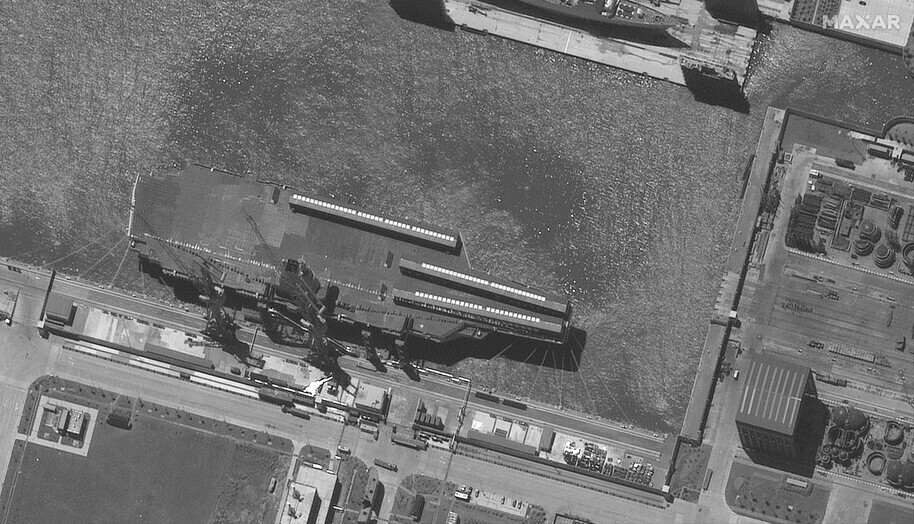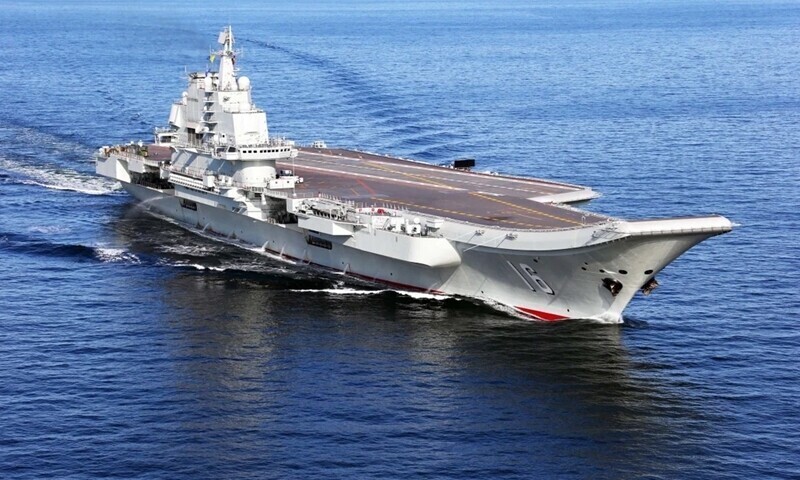hankyoreh
Links to other country sites 다른 나라 사이트 링크
China’s third aircraft carrier is a monument to Xi’s ambitions in the Pacific

China’s third aircraft carrier, dubbed the Fujian, was put to sea near Shanghai on June 17. The Chinese People’s Liberation Army (PLA) sprayed the carrier’s deck with huge jets of water and set off fireworks in an unabashed celebration of the carrier’s arrival. That was markedly different from China’s clandestine acquisition of a carrier partially built by the Soviets 24 years ago.
Keeping a low profile during the 1980sThe foreign policy maxim of former Chinese President Deng Xiaoping, who led China’s economic opening up in the 1980s, was “taoguang yanghui.” The phrase, often translated as “keep a low profile,” literally means “hide the gleam of the blade and accrue power in the shadows.” Since China was in no position for independent action at that time, this sort of approach was needed if China was to grow without interference from Western powers.
The Chinese were terrified that the outside world would learn of their wishes to acquire aircraft carriers. In the 1980s, China began buying decommissioned aircraft carriers from Australia and other countries under the guise of scrap metal reclamation and entertainment purposes.
Then in 1998, China purchased the hulk of a partially completed aircraft carrier from Ukraine dating back to the Soviet period. A tourist company in Macao told Ukraine it was planning to build a floating casino, disguising its real purpose, as well as the actual buyer. The nominal buyer was a ghost company without an office, and the company’s board included former PLA officers.
In 2002, China brought the hulk not to Macao but to the military port of Dalian to be studied. But the Chinese authorities angrily rejected assertions in the Western media that it was trying to acquire an aircraft carrier.
The People’s Daily, the organ of the Chinese Communist Party, said in December 2002 that claims about a Chinese aircraft carrier were a product of the Western narrative about the threat of China and said that China didn’t need aircraft carriers given its focus on economic development.

After becoming Chinese president in 2003, Hu Jintao conceived the notion of “heping jueqi,” or “China’s peaceful rise.” That expressed China’s intention of rising high in the world peacefully, while no longer concealing its abilities. That peaceful rise was epitomized by the Beijing Olympics in 2008.
It was then that China clearly expressed its intention of acquiring a carrier. China’s Ministry of National Defense said during a briefing of the domestic and foreign press in December 2008 that China would “seriously consider ‘relevant issues’ with ‘factors in every aspects’ on building its first ever aircraft carrier.”
Then in September 2012, four years later, China unveiled an aircraft carrier it had built from the hulk bought from Ukraine and christened Liaoning. This was an old-fashioned carrier with a ski-jump jet launcher, diesel propulsion and a displacement of over 60,000 metric tons.
After Xi takes office, a second carrier in 4 yearsAfter taking control of China in 2013, Xi Jinping announced the Belt and Road Initiative. Under the expansionist slogan of “one belt, one road,” Xi declared that he would link China with parts of the world little-touched by American power in Southeast Asia, Central Asia, Europe and Africa.
As part of that initiative, China began a massive construction project involving ports, roads and railroads. Xi also coined the concepts of the “great rise of the Chinese people” and the “Chinese dream,” echoing the American dream.
Construction on China’s second aircraft carrier, christened Shandong, began in 2013, shortly after Xi became president, and was completed four years later in 2017. That was a huge leap in development considering that it took China 14 years to complete its first aircraft carrier, which was already 70% built at the time of acquisition.
The Shandong carrier is roughly similar to the Liaoning in terms of size and functionality. The new carrier went into active service in 2019, two years after its launch.

China has gradually been shifting its attention to the Pacific Ocean, which has been referred to as the US’ “backyard.” In April, China signed a security agreement with the Solomon Islands in the South Pacific. It has also helped Kiribati, another island country in the area, revamp an old runway.
Chinese Foreign Minister Wang Yi attempted to reach a security and military agreement with yet another country in the South Pacific during a visit at the end of May.
Amid these developments, China launched its third carrier on Friday, June 17. The carrier is equipped with an aircraft catapult that maximizes the capacity of deck planes.
China christened the carrier Fujian, the name of the province across from Taiwan. Analysts think the name is aimed at sending a warning to Taiwan and checking its ambitions.
China’s goal is to acquire six aircraft carriers by 2035 to prevent US carrier strike groups from approaching within 1,000 kilometers of the Taiwan Strait. In addition, China has also been arguing that the Taiwan Strait doesn’t count as international waters under the UN Convention on the Law of the Sea.
By Choi Hyun-june, Beijing correspondent
Please direct questions or comments to [english@hani.co.kr]

Editorial・opinion
![[Editorial] Penalties for airing allegations against Korea’s first lady endanger free press [Editorial] Penalties for airing allegations against Korea’s first lady endanger free press](https://flexible.img.hani.co.kr/flexible/normal/500/300/imgdb/original/2024/0502/1817146398095106.jpg) [Editorial] Penalties for airing allegations against Korea’s first lady endanger free press
[Editorial] Penalties for airing allegations against Korea’s first lady endanger free press![[Editorial] Yoon must halt procurement of SM-3 interceptor missiles [Editorial] Yoon must halt procurement of SM-3 interceptor missiles](https://flexible.img.hani.co.kr/flexible/normal/500/300/imgdb/child/2024/0501/17145495551605_1717145495195344.jpg) [Editorial] Yoon must halt procurement of SM-3 interceptor missiles
[Editorial] Yoon must halt procurement of SM-3 interceptor missiles- [Guest essay] Maybe Korea’s rapid population decline is an opportunity, not a crisis
- [Column] Can Yoon steer diplomacy with Russia, China back on track?
- [Column] Season 2 of special prosecutor probe may be coming to Korea soon
- [Column] Park Geun-hye déjà vu in Yoon Suk-yeol
- [Editorial] New weight of N. Korea’s nuclear threats makes dialogue all the more urgent
- [Guest essay] The real reason Korea’s new right wants to dub Rhee a founding father
- [Column] ‘Choson’: Is it time we start referring to N. Korea in its own terms?
- [Editorial] Japan’s rewriting of history with Korea has gone too far
Most viewed articles
- 160% of young Koreans see no need to have kids after marriage
- 2Presidential office warns of veto in response to opposition passing special counsel probe act
- 3Months and months of overdue wages are pushing migrant workers in Korea into debt
- 4Hybe-Ador dispute shines light on pervasive issues behind K-pop’s tidy facade
- 5Japan says it’s not pressuring Naver to sell Line, but Korean insiders say otherwise
- 6[Reporter’s notebook] In Min’s world, she’s the artist — and NewJeans is her art
- 7[Editorial] Penalties for airing allegations against Korea’s first lady endanger free press
- 8Inside the law for a special counsel probe over a Korean Marine’s death
- 9OECD upgrades Korea’s growth forecast from 2.2% to 2.6%
- 10[Exclusive] Hanshin University deported 22 Uzbeks in manner that felt like abduction, students say